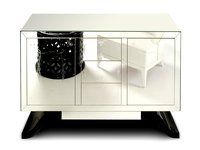Those buildings constructed or renewed according
to the most recent legal requirements off er
a remarkable potential of increasing energy
effi ciency, but in order to fully embrace it, it is
necessary to optimize the operation of all technical
plants; this is what building automation system
do. These systems feature advanced functions in
order to regulate all technical plants present in
the building itself such as heating, cooling, ventilation and air conditioning, hot water
production, sun shades and lighting. According to standard UNI EN 15232, while
designing it is possible to evaluate how much energy it is possible to save based on the
various levels of automation systems that can be selected, thus placing the building in
one of the four defi ned effi ciency classes: from class A (the most effi cient) to D (less
effi cient). The standard was fi rst published back to 2007, but was later updated in 2012
and 2017; in 2017, the guide CEI 205-18 for the use of the standard was also published.
Among the functions aff ecting the building energy performance there is also lighting,
both singularly and in combination with sun shade control and HVAC functions (heating,
cooling, ventilation). Lighting corresponds to category M9 in the modular EPB standard
structure for the building technical plants. Effi ciency classes refer to the fundamental
concepts of BAC and TBM:
BAC (Building Automation Control): is a set of products, software and technical
services aimed at performing automatic adjustment, monitoring and optimization,
human intervention and management, in order to allow all plants to achieve a high level
of energy effi ciency which is both safe and economic;
TBM (Technical Building Management): is a process or a set of processes and
services related to building management, operation and technical services, through the
inter-relations between diff erent disciplines and activities.
The defi nition of the four energy effi ciency classes include:
Class A: corresponds to high performance BACs and TBM functions
Class B: corresponds to advanced BACs and some TBM specifi c functions
Class C: corresponds to standard BACs
Class D: corresponds to non-effi cient BACs. Class D buildings should be retrofi tted.
New buildings should not be built using these systems.
Bac effi ciency factors
The BAC effi ciency factor method (fBAC) was added to the standard in order to quickly and
easily estimate how much automation, regulation and management functions can aff ect
the energy performance of a building. Because of this, this method is especially useful
in the fi rst stages of the building design, when a lot of detailed information are not yet
available. To this end, the standard provides a table with the BAC effi ciency factors, even
separately for thermal (fBAC, th) and electrical (fBAC, el). consumptions. These are indexes
based on a large number of simulations, obtained by comparing the annual consumptions
of a reference environment for diff erent levels of automation.
Generally speaking, in a building electrical energy is divided in uses related to lighting
(L) and electrical auxiliaries (aux). Factors may vary depending on the building topology
(residential or commercial) and destination of use (offi ces, schools, etc.). Factors for the
reference effi ciency class (C) are conventionally set to 1; moving towards higher energy
effi ciency classes (B and A) always leads to lower fBAC factor values and, consequently,
to a better energy performance.
In case of offi ce environments, for example, moving from Class C to Class A corresponds
to a 28% of energy saved, while for a residential building the same change in class
means a 8% of energy saved.
Normative and legislative references
UNI EN 15232-1:2017 Energy performance of buildings - Part 1: Impact of automation,
control and technical management of buildings
CEI 205-18:2017 Guide for the use of EN 15232 - Classifi cation of automation systems
of technical installations in buildings, identifi cation of functional diagrams, estimation
of the contributions of these systems to the reduction of energy consumption
Interministerial Decree of 26 June 2015 - Adaptation of national guidelines for the
energy certifi cation of buildings.
A
B
C
D
Energy efficiency
BUILDING
Building
BAC efficiency factors for lighting (fBAC, el, L)
D
C
(reference)
B
A
Not efficient
Standard
Advanced
High energy
efficiency
Non-
residential
Offices
1,1
1
0,85
0,72
Reading rooms
1,1
0,88
0,76
Schools
1,1
0,88
0,76
Hospitals
1,2
1
1
Hotels
1,1
0,88
0,76
Restaurants
1,1
1
1
Commercial
1,1
1
1
Residential
Single houses
1,08
0,93
0,92
Apartments
Other types
Minimum effi ciency class
The June 25th 2015 inter-ministerial decree (“Minimum requirements”) requires,
for non-residential buildings, a minimum automation level corresponding to
energy effi ciency Class B, in compliance with standard UNI EN 15232 for control,
regulation and management of building technologies and thermal plants (BACS).
In order to match Class B, at least the automation functions regarding lighting
have to be implemented (see Table B in the following page); moreover, all devices
must be able to communicate with building control system.
ENERGY EFFICIENCY CLASSES
Residential
Non-residential
D
C
B
A
D
C
B
A
5
LIGHTING CONTROL
5.1
Presence control (M9.5)
0
Manual ON/OFF switch
1
Manual ON/OFF switch + automatic gradual extinction
2
Automatic detection (automatic switch ON)
3
Automatic detection (manual switch ON)
5.2
Daylight control
0
Manual (centralized)
1
Manual (for each environment/zone)
2
Automatic switching
3
Automatic dimming
6
SUN SHADE CONTROL
6.1
Sun shade control (M2.5/M2.8/M9-5)
0
Completely manual
1
Motorized with manual actuator
2
Motorized with automatic actuator
3
Combined light/shutter/HVAC control
Source: UNI EN 15232-1 Building energy performance – Part 1: eff ects of building automation, control and technical management – Modules M10-4,5,6,7,8,9,10Extract regarding BAC functions for lighting control
(point 5) and sun shade control (point 6).
SMART LIGHTING
SMART LIGHTING
106
107







